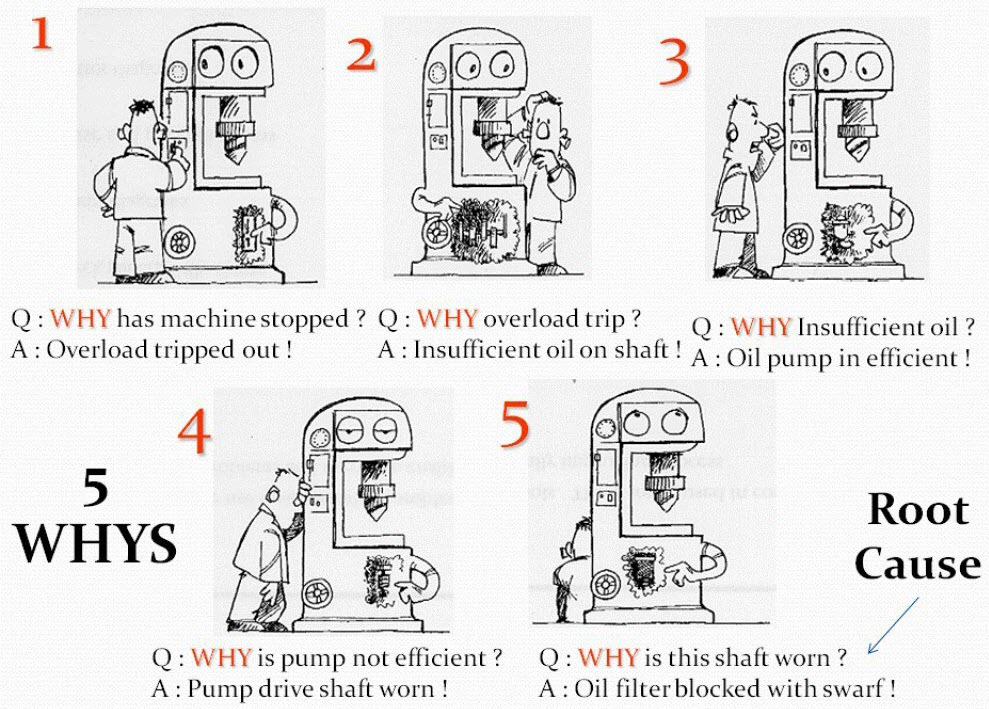The 5 whys problem solving strategy is targeted at discovering the root cause of a particular problem. This was developed by Toyota and is very effective. The fundamental idea is to get to the root of a problem by continuously asking “Why?” for at least five times until you get to the basic root cause. Doing this will allow the corrective action to be aimed at the fundamental problem instead of paying attention to fixes that targets the symptoms and will only last for a short term.
Hence, the 5 whys problem solving technique inspires a questioning mind set. Whenever an issue occurs, workers should not just consider the fastest solution because, most times, this only deals with the symptoms and not the problem itself. Rather, further probing should be done until the real underlying problem is discovered.
In manufacturing, the 5 whys problem solving technique is very effective because it can swiftly be used to discover the cause of quality problems or defects. This strategy also has the benefit of encouraging team work as well as combined problem solving among employees. Also, it is of low cost, quick and as a result of its simplicity, little training is required and it keeps the employees engaged.
When Should the 5 Whys Problem Solving Be Used
The 5 whys problem solving technique is most efficient whenever used to find solutions for simple to averagely challenging problems. If you are making use of the 5 whys problem solving strategy for complex issues, there are usually multiple root causes. Making use of the 5 whys can lead one down only one path and cause you to overlook several other basic problems.
As a result of its simplicity, the 5 whys problem solving technique is an amazing tool to avoid brainstorming about an issue without taking an in-depth look.
How the 5 Whys Problem Solving Technique Works
Assemble Your Team
First thing to do is to invite individuals who are aware of the problem that needs to be fixed to a meeting.
Select a Facilitator for Your Meeting
A facilitator is required to lead the meeting, ask the 5 whys and make the team pay attention to the problem at hand.
Define the Problem
Analyse the problem with the team and try to create a vivid and precise statement of the problem. To begin, answer the various questions; what’s happening? When did it occur? Where did it occur? And who was the first to realize the problem?
The problem statement should be written on a board leaving adequate space to put the answers to the 5 whys below.
Ask Why Five Times
The very first of the 5 whys problem solving technique should be ‘why the issue is occurring?’ This would work best if the answer is gotten from facts. Guessing is not allowed. Make sure not to use deductive reasoning as this can muddy the whole process. Give answers to each question swiftly so as to avoid jumping into conclusions.
Keep on asking ‘why?’ until you think you have analysed each path and can’t go forward anymore. If you got more than one reason for your first why, then you can go back and replicate the procedure until all the routes have been explored.
Address the Root Causes
By the time you get to this step, the exact root cause should have been identified. A discussion with the 5 whys team should be had in order to determine the countermeasures that can be used to resolve the issue and prevent it from occurring again. The facilitator can then assign the responsibilities for these countermeasures to various members of the team.
Keep Track of Your Countermeasures
Addressing the root cause is not the end of the 5 whys problem solving strategy. It is essential to keep track of how efficient the countermeasures minimized or solved the issue. If no change has been made, then, the wrong root cause might have been identified and thus, the process has to be repeated.
Although, the 5 whys problem solving technique was originally designed to be used within a manufacturing environment, it can however, be used in a broad variety of applications.






